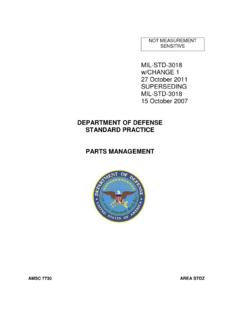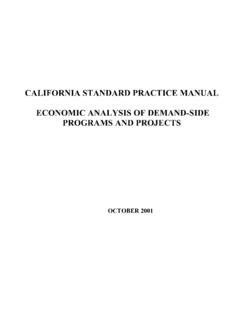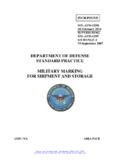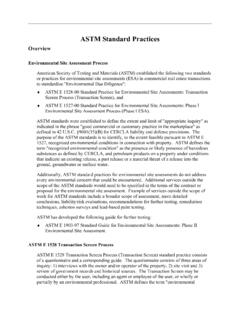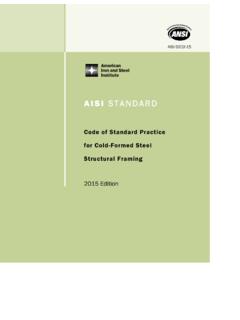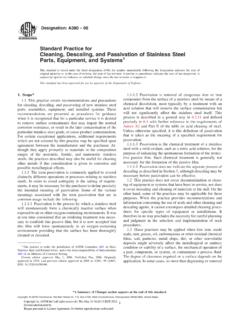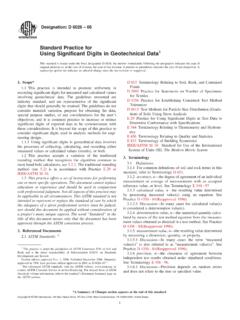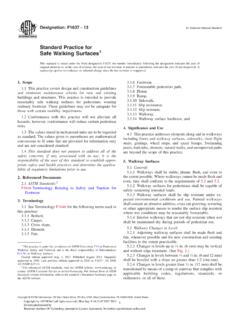Transcription of Standard Practice for Preparing Concrete Floors to Receive ...
1 Designation: F 710 05 Standard Practice forPreparing Concrete Floors to Receive Resilient Flooring1 This Standard is issued under the fixed designation F 710; the number immediately following the designation indicates the year oforiginal adoption or, in the case of revision, the year of last revision. A number in parentheses indicates the year of last reapproval. Asuperscript epsilon (e) indicates an editorial change since the last revision or This Practice covers the determination of the acceptabil-ity of a Concrete floor for the installation of resilient This Practice includes suggestions for the constructionof a Concrete floor to ensure its acceptability for installation ofresilient This Practice does not cover the adequacy of theconcrete floor to perform its structural This Practice covers the necessary preparation of con-crete Floors prior to the installation of resilient This Practice does not supersede in any manner theresilient flooring or adhesive manufacturer s written instruc-tions.
2 Consult the individual manufacturer for specific Standard does not purport to address all of thesafety concerns, if any, associated with its use. It is theresponsibility of the user of this Standard to establish appro-priate safety and health practices and determine the applica-bility of regulatory limitations prior to , , specific warning The values stated in inch-pound units are to be regardedas Standard . The values in parentheses are mathematicalconversions to SI units and are provided for information Referenced standards :2C 109/C 109 MTest Method for Compressive Strength ofHydraulic Cement MortarsC 309 Specification for Liquid Membrane-Forming Com-pounds for Curing ConcreteC 472 Test Method for Compressive Strength of GypsumCementD 4259 Practice for Abrading ConcreteE 1155 Test Method for Determining FF/FL ( floor Flatnessand floor Levelness)
3 E 1486 Test Method for Determining floor Tolerances Us-ing Waviness, Wheel Path, and Levelness CriteriaE 1745 Specification for Plastic Water Vapor RetardersUsed In Contact With Soil or Granular Fill Under ConcreteSlabsF 141 Terminology Relating to Resilient floor CoveringsF 1869 Test Method for Measuring Moisture Vapor Emis-sion Rate of Concrete Subfloor Using Anhydrous CalciumChlorideF 2170 Test Method for Determining Relative Humidity inConcrete floor Slabs Using In Situ ProbesNOTE1 Specifications and test methods for cements and other relatedmaterials are found in ASTM Volume Specifications and testmethods for concretes and related materials are found in ASTM Guide for Concrete floor and Slab Construction117R Standard Tolerances for Concrete Construction floor Covering Institute (RFCI):4 Recommended Work practices for the Removal of ResilientFloor standards :MASTERSPEC Guide Spec Section 03300, Cast-In-Place Concrete 5 SPECTEXT Guide Spec Section 03346, Concrete FloorFinishing 63.
4 For definitions of terms used in thispractice, see TerminologyF General Concrete Floors to Receive resilient flooring shall bepermanently dry, clean, smooth, and structurally sound. Theyshall be free of dust, solvent, paint, wax, oil, grease, residual1 This Practice is under the jurisdiction of ASTM Committee F06 on ResilientFloor Coverings and is the direct responsibility of Subcommittee edition approved Feb. 1, 2005. Published March 2005. Originallyapproved in 1981. Last previous edition approved in 2003 as F 710 referenced ASTM standards , visit the ASTM website, , orcontact ASTM Customer Service at ForAnnual Book of ASTMS tandardsvolume information, refer to the Standard s Document Summary page onthe ASTM from American Concrete Institute, 19150 Redford Station, Detroit,MI floor Covering Institute, 966 Hungerford Drive, Rockville, from MASTERSPEC, AIA Master Systems, King Street Station, 225 Reinekers Lane, Suite 215, Alexandria, VA from SPECTEXT, National Institute of Building Sciences, 1090 Vermont Avenue, NW, Suite 700, Washington, DC ASTM International, 100 Barr Harbor Drive, PO Box C700, West Conshohocken, PA 19428-2959, United by ASTM Int'l (all rights reserved).
5 Fri Jul 6 17:52:14 EDT 2007 Downloaded/printed byLinda Lockwood () pursuant to License Agreement. No further reproductions , adhesive removers, curing, sealing, hardening, orparting compounds, alkaline salts, excessive carbonation orlaitence, mold, mildew, and other foreign materials that mightprevent adhesive Surface cracks, grooves, depressions, control joints orother non-moving joints, and other irregularities shall be filledor smoothed with latex patching or underlayment compoundrecommended by the resilient flooring manufacturer for fillingor smoothing, or both. Patching or underlayment compoundshall be moisture-, mildew-, and alkali-resistant, and, forcommercial installations, shall provide a minimum of 3000 psicompressive strength after 28 days, when tested in accordancewith Test Method C 109 or Test MethodC 472, whichever Joints such as expansion joints, isolation joints, orother moving joints in Concrete slabs shall not be filled withpatching compound or covered with resilient flooring.
6 Consultthe resilient flooring manufacturer regarding the use of anexpansion joint covering The surface of the floor shall be cleaned of all loosematerial by scraping, brushing, vacuuming, or other methods,or a combination thereof, as recommended by the resilientflooring manufacturer, immediately before commencing instal-lation of resilient Many resilient floorings may not be installed overconcrete when residual asphalt adhesive residue is the resilient flooring manufacturer s written recom-mendations concerning use of resilient flooring products inthese Concrete Floors shall be smooth to prevent irregularities,roughness, or other defects from telegraphing through the newresilient flooring. The surface of Concrete Floors shall be flat towithin the equivalent of3 16in. ( mm) in 10 ft, as describedin ACI117R, or as measured by the method described in TestMethodE 1155or any industry-recognized method more information regarding flatness Testing Concrete Floors to Receive resilient flooring shall be freeof sealers, coatings, finishes, dirt, film-forming curing com-pounds, or other substances which may affect the rate ofmoisture dissipation from the Concrete or the adhesion ofresilient flooring to the Concrete .
7 Non-chemical methods forremoval, such as abrasive cleaning or bead-blasting, includingmethods described in PracticeD 4259may be used on existingslabs with deleterious residues to achieve an appropriate statefor testing. Cleaning shall take place a minimum of 24 h Hydraulic cement used in Concrete con-struction may contain trace amounts of free crystalline exposure to airborne free crystalline silica may be ahealth hazard. Avoid actions that cause dust to become air-borne. Use local or general ventilation to control exposuresbelow applicable exposure Testing All Concrete slabs shall be tested formoisture regardless of age or grade level. For the preferredmoisture testing method and limits, consult the written instruc-tions from the floor covering manufacturer, the adhesivemanufacturer, the patching/underlayment manufacturer, orcombination thereof.
8 In the absence of manufacturer s guide-lines, refer toTable Consult the resilient flooring manufacturer, the adhe-sive manufacturer, the underlayment manufacturer s writteninstructions, or combination thereof, for their acceptable testmethods. If these instructions are in conflict, the most stringentrequirements shall Testing Concrete Floors shall be tested for pH priorto the installation of resilient flooring. Levels of pH shall notexceed the written recommendations of the resilient flooringmanufacturer or the adhesive manufacturer, or To test for pH at the surface of a Concrete slab, usewide range pH paper, its associated pH chart, and distilled ordeionized water. Place several drops of water on a cleansurface of Concrete , forming a puddle approximately 1 in. (25mm) in diameter. Allow the puddle to set for 6065 s, then dipthe pH paper into the water.
9 Remove immediately, and com-pare to chart to determine pH reading. Other pH testingmethods such as pH pencils or pH meters, or both, are availableand may be used to measure pH. Readings below and inexcess of have been known to affect resilient flooring oradhesives, or both. Refer to resilient flooring manufacturer swritten instructions for guidelines on acceptable testing meth-ods and acceptable pH levels. more informationabout pH levels in Concrete Preparation of New Concrete New Concrete slabs shall be properly cured and driedbefore installation of resilient flooring. Drying time beforeslabs are ready for moisture testing will vary depending onatmospheric conditions and mix design. moreinformation. Floors containing lightweight aggregate or excesswater, and those which are allowed to dry from only one side,such as Concrete on metal deck construction, may need a muchlonger drying time and should not be covered with resilientflooring unless the moisture vapor emission rate meets themanufacturer s installation Preparation of Existing Concrete The resilient flooring manufacturer shall be consultedregarding the necessity of removal of old resilient flooring,adhesive residue, paint, or other surface contaminants.
10 If oldresilient flooring, paint, or adhesive residue is to be removed, Do not sand, dry sweep, dry scrape, drill,saw, beadblast, or mechanically chip or pulverize existingresilient flooring, backing, lining felt, paint, asphaltic cutbackadhesives, or other adhesives. These products may containasbestos fibers or crystalline silica. Avoid creating dust. Inha-lation of such dust is a cancer and respiratory tract by individuals exposed to asbestos fibers greatlyincreases the risk of serious bodily harm. Unless positivelycertain that the product is a nonasbestos-containing material,TABLE 1 ASTM Test Methods for Concrete Moisture ReadingTest MethodMaximum LimitF 18693 lb/1000 ft2(170 g/m2) per 24 hF 217075 %F710 052 Copyright by ASTM Int'l (all rights reserved); Fri Jul 6 17:52:14 EDT 2007 Downloaded/printed byLinda Lockwood () pursuant to License Agreement.


